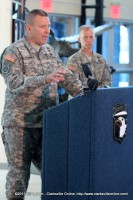F ort Campbell, KY – On Friday, Clarksville Online published the first of two pieces on a Thursday press conference with Brig. Gen. Mark Stammer, the acting commander of Fort Campbell, KY, while the 101st Airborne Division is deployed to Afghanistan about the Army’s Upcoming Force Reduction and Reorganization Strategy, and it’s effects on Fort Campbell.
ort Campbell, KY – On Friday, Clarksville Online published the first of two pieces on a Thursday press conference with Brig. Gen. Mark Stammer, the acting commander of Fort Campbell, KY, while the 101st Airborne Division is deployed to Afghanistan about the Army’s Upcoming Force Reduction and Reorganization Strategy, and it’s effects on Fort Campbell.
The first article from the interview calmed community fears about the possibility of a mass loss of personnel at the Army post. In the second we will be discussing the level of importance assigned to Fort Campbell by the U.S. Army and the U.S. Department of Defense.

The list of military forces stationed at Fort Campbell is impressive.
The 101st Airborne division is home to the 1st Brigade Combat Team “Bastogne”, 2nd Brigade Combat Team “Strike”, 3rd Brigade Combat Team “Rakkasan”, 4th Brigade Combat Team “Currahee”, 101st Combat Aviation Brigade “Wings of Destiny”, 159th Combat Aviation Brigade “Thunder”, 101st Sustainment Brigade “Lifeliners”, and the 101st Headquarters and Headquarters Battalion “Gladiators”.
In addition to the mighty 101st Airborne Division Fort Campbell is also the home of the 5th Special Forces Group, 160th Special Operations Aviation Regiment, Blanchfield Army Community Hospital, 86th Combat Support Hospital, U.S.A.F 19th Air Support Operations Squadron, 52nd Ordnance Group (EOD), U.S.A.F Detachment 4-18 Weather Squadron, and the 902nd Counterintelligence Field Office.
The Army’s Force Reduction and Reorganization Strategy will see the Army cutting its active Brigade Combat Teams from 45 to 33 by fiscal year 2017, as they work to cut the active-duty force from about 560,000 to 490,000 as we wind down from the wars in Iraq and Afghanistan. Overall it will see the Army as a whole drawing down by 14%, while the force structure at Fort Campbell is only being drawn down by about 1.1%.

“I think that the math there alone is very indicative of what Fort Campbell provides to the Army, and what it represents for the Army,” said Brig. Gen. Mark Stammer during the interview on Thursday. “We are very well-positioned as a strategic deployment platform. We have a number of organizations on Fort Campbell besides the 101st Airborne Division. It’s a great training environment. I think it also reflects very well on the civil military relations that we enjoy here in the greater Fort Campbell community both on the Tennessee side of the border, and the Kentucky side.”
He continued, “I think how they (the U.S. Army Leadership) look at Fort Campbell, is as one of the premier installations for the Army. I think the decision to reorganize Fort Campbell and the 101st Airborne Division the way the Army has decided to; is very reflective of how the Army thinks of Fort Campbell, and what we’re able to do here. At the end of the day we are going to be the third largest installation in the Army inventory for the active component; and I think that’s very indicative of the kind of product that we deliver here on this installation.”
Fort Campbell is going to lose roughly 320 soldiers, with the rest merged into the other 3 remaining Brigade Combat Teams; and that will have obvious impacts in the area’s economy and schools. “But we are talking about 320 people out of a post of over 28,000; while there will be an impact I believe that impact will be minimal,” said Stammer. “At the end of the day, there will still be three Brigade Combat Teams here, and they will continue to train, maintain, and prepare for their next rendezvous with destiny; but we will be doing it without the 4th Brigade Combat Team. Again the majority of the soldiers from the 4th Brigade Combat Team will simply be absorbed into the three remaining brigades in the form of infantry battalions and the associated enablers for that.”
Reorganizing Fort Campbell
One result of the upcoming reorganization will be a reapportionment of Fort Campbell among the remaining units, and the planning for that is already underway.
“Col. Dillinger and the Garrison has plans to recapitalize on all the existing infrastructure on this post, and redraw the lines to get the three remaining brigade combat teams in as contiguous of a footprint as possible to facilitate mission command and esprit de corps in those units,” said Stammer. “We will look to recapitalize as many of the existing structures as we can to cut the costs of any associated activations, re-activations, or restructuring.”
The Garrison Commander for Fort Campbell, Col. David L. Dellinger spoke more about this during his time at the podium.

“We feel like we’re pretty well-positioned to move the units around and get them into the contiguous footprints that Brig. Gen. Stammer referred to,” said Col. Dellinger.
“We’re not going to have excess space because the loss of a brigade headquarters,” he said. “The battalions are still going to be there.”
He continued, “We’ve identified where all the Battalion headquarters and company headquarters are; and we are ready to give the remaining brigades an updated footprint, and let them organize themselves as they see fit within that footprint”
Dellinger also spoke about the ongoing investments in modernizing Fort Campbell’s infrastructure, “Fort Campbell has been well provided for over the last 10 to 12 years,” he said. “So we have a strong foundation ready as we work on getting our units under the new organizational system, and into facilities that will meet their requirements.”
He then moved on to Fort Campbell’s contribution to the local economy, “In fiscal year 2012 we put $4.7 billion into the economy around here that’s military pay, retirement pay, the $492 million of military construction that we have going on. So we’ve looked at all of this, and it was carefully considered as part of the military value analysis and environmental analysis that we did when we found out that these 320 people who are not going to be on Fort Campbell by FY17. So potentially in FY13, 14, 15 we might be putting $4.699 billion into the economy in this area. It’s hard to put an exact number on what the spending power of the 320 people we will end up losing is.”
Brig. Gen. Stammer retook the podium.
“I think the key messages that we’re restructuring, we’re reorganizing, and this is not going to occur overnight. It’s not going to happen tomorrow,” he said. “This is not sequestration,” he assured us; “This is a reorganization due to the Congressional Budget Act, and the Army’s new strategy.” He concluded, “Fort Campbell is very well-positioned now, during these changes, and very well in the future as a great place to train, a great place to live, and a great place to raise a family. Thank you very much!”


